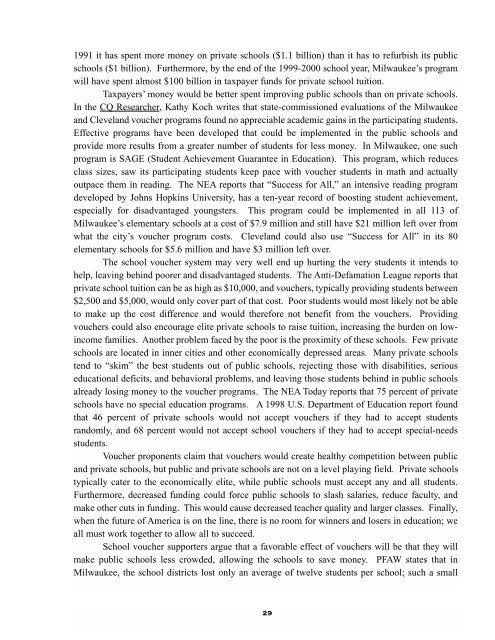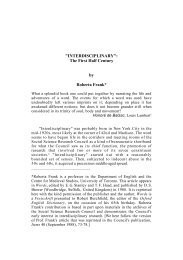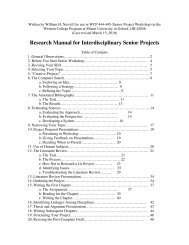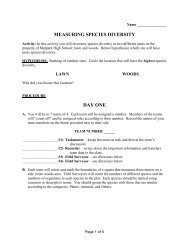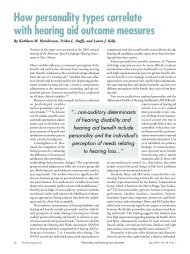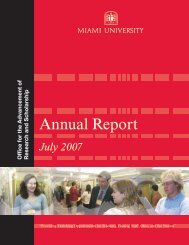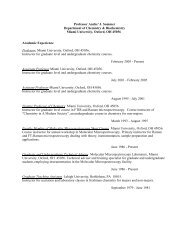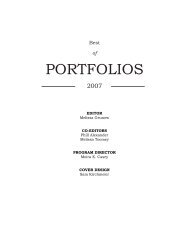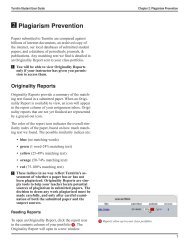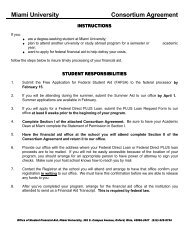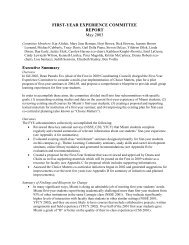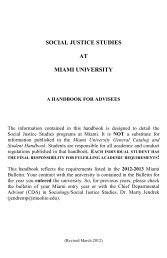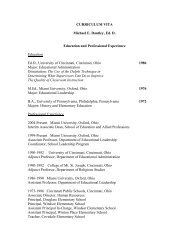Best of Miami Portfolios 2001 - Units.muohio.edu
Best of Miami Portfolios 2001 - Units.muohio.edu
Best of Miami Portfolios 2001 - Units.muohio.edu
You also want an ePaper? Increase the reach of your titles
YUMPU automatically turns print PDFs into web optimized ePapers that Google loves.
1991 it has spent more money on private schools ($1.1 billion) than it has to refurbish its public<br />
schools ($1 billion). Furthermore, by the end <strong>of</strong> the 1999-2000 school year, Milwaukee’s program<br />
will have spent almost $100 billion in taxpayer funds for private school tuition.<br />
Taxpayers’ money would be better spent improving public schools than on private schools.<br />
In the CQ Researcher, Kathy Koch writes that state-commissioned evaluations <strong>of</strong> the Milwaukee<br />
and Cleveland voucher programs found no appreciable academic gains in the participating students.<br />
Effective programs have been developed that could be implemented in the public schools and<br />
provide more results from a greater number <strong>of</strong> students for less money. In Milwaukee, one such<br />
program is SAGE (Student Achievement Guarantee in Education). This program, which r<strong>edu</strong>ces<br />
class sizes, saw its participating students keep pace with voucher students in math and actually<br />
outpace them in reading. The NEA reports that “Success for All,” an intensive reading program<br />
developed by Johns Hopkins University, has a ten-year record <strong>of</strong> boosting student achievement,<br />
especially for disadvantaged youngsters. This program could be implemented in all 113 <strong>of</strong><br />
Milwaukee’s elementary schools at a cost <strong>of</strong> $7.9 million and still have $21 million left over from<br />
what the city’s voucher program costs. Cleveland could also use “Success for All” in its 80<br />
elementary schools for $5.6 million and have $3 million left over.<br />
The school voucher system may very well end up hurting the very students it intends to<br />
help, leaving behind poorer and disadvantaged students. The Anti-Defamation League reports that<br />
private school tuition can be as high as $10,000, and vouchers, typically providing students between<br />
$2,500 and $5,000, would only cover part <strong>of</strong> that cost. Poor students would most likely not be able<br />
to make up the cost difference and would therefore not benefit from the vouchers. Providing<br />
vouchers could also encourage elite private schools to raise tuition, increasing the burden on lowincome<br />
families. Another problem faced by the poor is the proximity <strong>of</strong> these schools. Few private<br />
schools are located in inner cities and other economically depressed areas. Many private schools<br />
tend to “skim” the best students out <strong>of</strong> public schools, rejecting those with disabilities, serious<br />
<strong>edu</strong>cational deficits, and behavioral problems, and leaving those students behind in public schools<br />
already losing money to the voucher programs. The NEA Today reports that 75 percent <strong>of</strong> private<br />
schools have no special <strong>edu</strong>cation programs. A 1998 U.S. Department <strong>of</strong> Education report found<br />
that 46 percent <strong>of</strong> private schools would not accept vouchers if they had to accept students<br />
randomly, and 68 percent would not accept school vouchers if they had to accept special-needs<br />
students.<br />
Voucher proponents claim that vouchers would create healthy competition between public<br />
and private schools, but public and private schools are not on a level playing field. Private schools<br />
typically cater to the economically elite, while public schools must accept any and all students.<br />
Furthermore, decreased funding could force public schools to slash salaries, r<strong>edu</strong>ce faculty, and<br />
make other cuts in funding. This would cause decreased teacher quality and larger classes. Finally,<br />
when the future <strong>of</strong> America is on the line, there is no room for winners and losers in <strong>edu</strong>cation; we<br />
all must work together to allow all to succeed.<br />
School voucher supporters argue that a favorable effect <strong>of</strong> vouchers will be that they will<br />
make public schools less crowded, allowing the schools to save money. PFAW states that in<br />
Milwaukee, the school districts lost only an average <strong>of</strong> twelve students per school; such a small<br />
29


